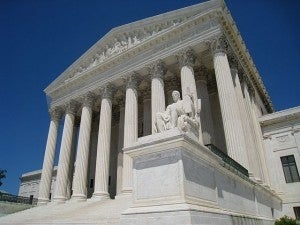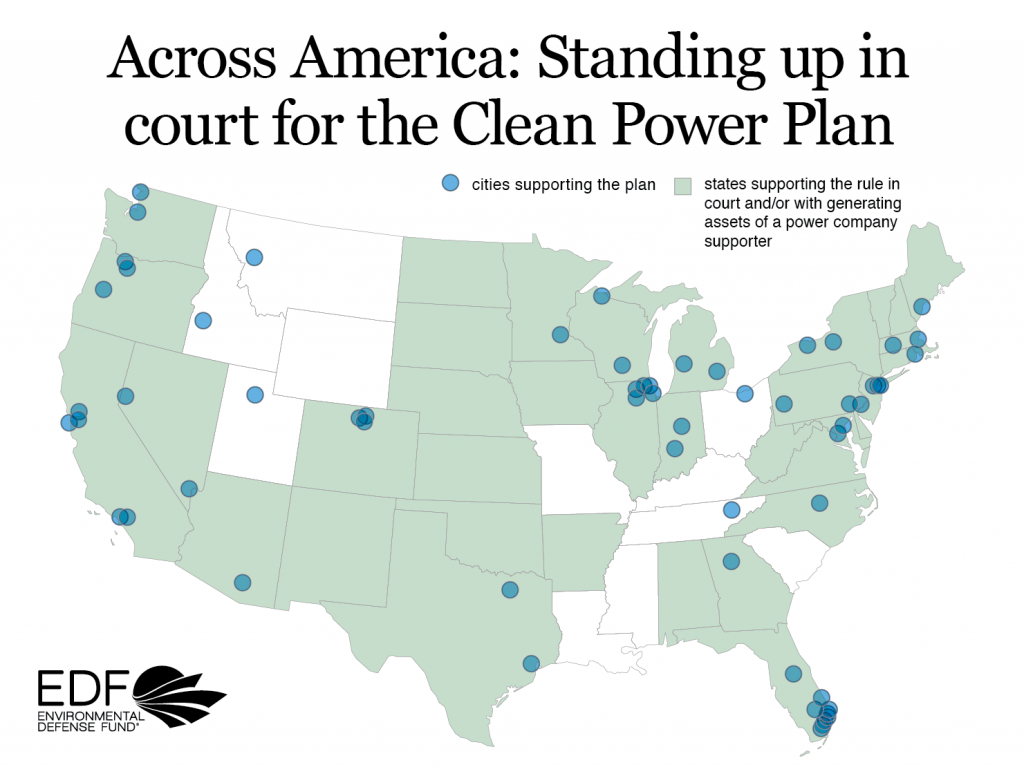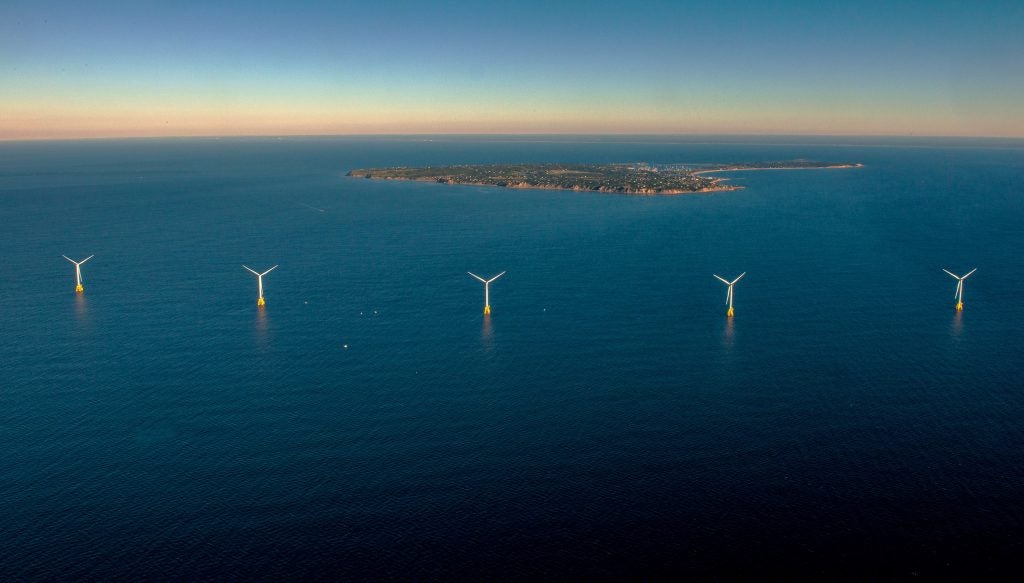 Environmental Defense Fund and fourteen other public health and environmental organizations filed a brief yesterday urging the United States Court of Appeals for the D.C. Circuit to issue a decision on the merits in the litigation over the Clean Power Plan – America’s only nationwide standards limiting harmful carbon pollution from existing fossil fuel power plants.
Environmental Defense Fund and fourteen other public health and environmental organizations filed a brief yesterday urging the United States Court of Appeals for the D.C. Circuit to issue a decision on the merits in the litigation over the Clean Power Plan – America’s only nationwide standards limiting harmful carbon pollution from existing fossil fuel power plants.
Other parties supporting the Clean Power Plan also filed briefs, including 18 states and 7 municipalities, power companies representing nearly 10 percent of the nation’s generation, and associations representing America’s vibrant $200 billion clean energy industry.
The latest filings all respond to a recent D.C. Circuit order which temporarily suspended the litigation and directed the parties to submit briefs on whether to continue the suspension (known as an “abeyance”) or terminate the case and hand the matter back to the Environmental Protection Agency (EPA) for further review (known as “remand”).
This order addressed a motion filed by the Trump Administration on March 28, which asked the court to suspend the Clean Power Plan litigation indefinitely and refrain from deciding the legal merits of the Clean Power Plan.
Here’s what’s at stake at this critical juncture in the Clean Power Plan litigation – and a few things we can count on regardless of how the court rules on yesterday’s filings.
Real World Consequences for Healthier Air and a Safer Climate
The briefs have vital real-world consequences for everyone who cares about healthier air and a safer climate.
As legal experts have noted, the Administration’s move is a brazen, eleventh-hour attempt to prevent the D.C. Circuit from issuing a timely opinion on legal issues that are central to EPA’s responsibility under the Clean Air Act to protect the public against climate pollution. The Administration filed its March 28 motion almost a year after the parties submitted briefs in the case, and six months after ten judges of the D.C. Circuit held an exhaustive seven hour-long oral argument.
Because the Supreme Court voted 5-to-4 to temporarily block the enforcement of the Clean Power Plan while the courts reviewed the legal challenges, the Administration’s motion would also indefinitely delay the enforcement of these urgently needed and long-overdue limits on carbon pollution.
The Administration’s motion asked the court for an indefinite pause in the litigation while EPA undertakes the long process of reviewing – and likely rescinding or weakening – the Clean Power Plan. However, if the court declines to decide the central legal questions in this case now, the same issues would likely have to be re-litigated again after EPA has completed its review. This would add years of unnecessary delay at a time when the urgency of action to mitigate climate pollution has never been greater.
Americans have been waiting for protection from climate pollution from power plants for almost twenty years — with no relief:
- In 1998, EPA’s General Counsel Jonathan Cannon concluded in a memorandum to the EPA Administrator that EPA has authority to regulate carbon dioxide from power plants under the Clean Air Act – but EPA took no action to address the issue.
- In 2003, environmental organizations filed a complaint against EPA in federal district court seeking carbon dioxide standards for fossil fuel-fired power plants under section 111 of the Clean Air Act.
- In 2006, states and environmental organizations filed a legal challenge in the D.C. Circuit to EPA’s failure to establish carbon dioxide standards for power plants under the Clean Air Act.
- In 2007, the Supreme Court issued its landmark decision in Massachusetts v. EPA, which affirmed that climate pollution is subject to regulation under the Clean Air Act. The D.C. Circuit then remanded the 2006 lawsuit to EPA to address the issue of establishing carbon dioxide standards for power plants.
- In 2010, states, public health, and environmental organizations reached a settlement with EPA in which the agency committed to finalizing carbon pollution standards for new and existing power plants by 2012 – a deadline that the agency failed to meet.
- In 2011, the Supreme Court relied on EPA’s authority under section 111 of the Clean Air Act as a basis for dismissing suits filed by states for common law damages against some of the nation’s most polluting power companies — holding that section 111 “speaks directly” to the problem of climate pollution from power plants.
- In 2015, after almost two years of intensive public outreach and after considering millions of public comments — and using its authority under section 111 of the Clean Air Act — EPA adopted the Clean Power Plan.
- In 2016, a closely divided Supreme Court voted 5-to-4 to temporarily block the enforcement of the Clean Power Plan pending judicial review of the merits.
Affected communities and vulnerable populations have waited long enough for action to protect our health and climate, while more and more climate pollution is accumulating in the atmosphere. That’s why the court should decide this case now rather than leaving climate protection in long-term legal limbo.
The Urgent Need for Limits on Carbon Pollution from the Nation’s Power Plants
The Clean Power Plan is a common sense climate and public health protection that will carbon reduce pollution from one of the nation’s largest sources, saving thousands of lives each year and protecting the health of all Americans.
The Clean Power Plan gives states and power companies tremendous flexibility in deciding how to reduce carbon pollution, including through cost-effective energy efficiency measures that save families money. Investments in clean energy and energy efficiency are already growing rapidly, employing over three million Americans and bringing hundreds of millions of dollars in revenue each year to low-income and rural areas.
That’s why a strikingly broad and diverse coalition emerged to defend the Clean Power Plan in court. The coalition includes: eighteen states and sixty municipalities; power companies that own and operate nearly ten percent of the nation’s generating capacity; leading businesses like Amazon, Apple, Google, Mars, and IKEA; former Republican heads of EPA; public health and environmental organizations; consumer and ratepayer advocates; faith organizations; and many others.
Coal producers, coal-intensive power companies, and their political allies have waged a massive, years-long litigation effort to thwart any limits whatsoever on climate-destabilizing pollution from power plants. Their campaign recently got an assist when the Trump Administration issued an executive order on March 28 that took aim at the Clean Power Plan and many other vital clean air protections.
In response to that executive order, an extraordinary array of leading businesses, faith leaders, medical associations, state and municipal officials, and other stakeholders have spoken out against the Administration’s threats to climate and health protections or vowed to continue moving towards a low-carbon future.
In recent weeks, dissent has emerged even within the coalition challenging the Clean Power Plan: North Carolina formally withdrew its challenge to the Clean Power Plan on February 23.
Millions of Americans in red and blue states – including a majority of Americans in every Congressional district in the country – support strong action to reduce carbon pollution from existing power plants. This public chorus reflects an understanding of the growing hazards of climate change, which is already affecting public health and well-being in a host of ways.
America has been demanding action from EPA since 2003, has been told multiple times by the Supreme Court that EPA has authority to act, and is now counting on the D.C. Circuit to resolve key legal questions about the scope of that authority. For that reason, our brief argues that the most fair and efficient course of action for the Court is to resolve those questions now.
EPA is Required to Act. It’s Up to All of Us to Make Sure EPA Fulfills That Obligation
Regardless of how the Court rules on today’s filings, a few critical facts will remain unchanged:
- EPA has a clear legal obligation to protect the public from carbon pollution. The Supreme Court has affirmed EPA’s authority to regulate greenhouse gases under the Clean Air Act three times since 2007, including EPA’s authority to limit carbon pollution from power plants under the Clean Air Act provision that is the basis for the Clean Power Plan.
- EPA’s carbon pollution standards for new power plants remain in full force and effect. Separate from the Clean Power Plan, EPA adopted carbon pollution standards for new, modified, and reconstructed fossil fuel-fired power plants in August 2015. Although those standards have also been the target of legal challenges by polluters and their allies, the enforcement of those standards has not been blocked by the courts. They will remain in full force and effect regardless of how the Court acts.
- EPA can’t roll back the Clean Power Plan or the carbon pollution standards for new power plants without public comment or judicial review. Even if the court declines to issue an opinion and instead suspends the litigation or remands the rule to EPA, the Clean Power Plan would still be the law of the land. Any attempt to withdraw or modify the Clean Power Plan (or the carbon pollution standards for new power plants) would first have to go through the same rigorous public notice and comment process that EPA carefully followed in adopting them. Such changes would also be subject to judicial review in the federal courts, and would be set aside if they are contrary to the Clean Air Act or do not rest on sound technical and policy foundations.
Americans all across the country are demanding an end to the era of unlimited carbon pollution from power plants.
In the face of the Trump Administration’s assault on common sense protections, the Environmental Defense Fund is ready to fight harder than ever for healthier air and a safer climate for our children.













 (EDF Attorney Ben Levitan co-authored this post)
(EDF Attorney Ben Levitan co-authored this post)